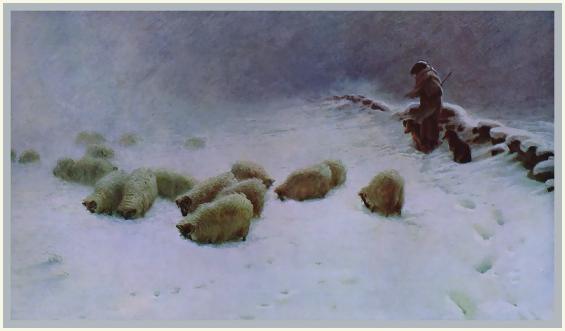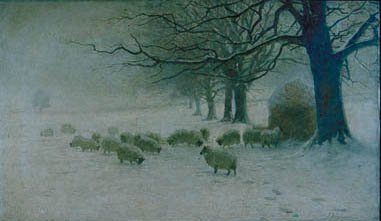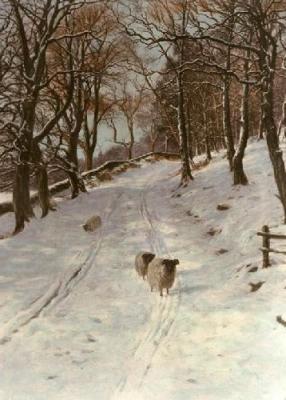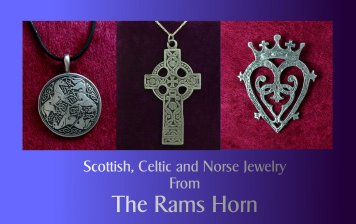A Shepherd looks at Joseph Farquharson
By Beth Maxwell Boyle
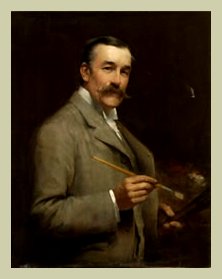
Born Edinburgh, May 4, 1846; died at Finzean, Aberdeenshire, April 15, 1935
Born in Edinburgh, Scotland in 1846, Joseph Farquharson combined a long and prolific career as a painter with his inherited role as a Scottish laird. He painted in both oils and water colors. His mother, a celebrated beauty, was an Ainslie. His early days were spent in his father's house in Northumberland Street below Queen Street Gardens and later at Eaton Terrace beyond the Dean Bridge, Edinburgh and at Finzean. His father Francis was a doctor and laird of Finzean in Aberdeenshire. Joseph was educated in Edinburgh and permitted by his father to paint only on Saturdays using his father’s paint box. When Joseph reached the age of 12, Francis Farquharson bought his son his first paints he could call his own and only a year later he exhibited his first painting at the Royal Scottish Academy. His first major portrait was of ' Miss Alice Farquhar ' exhibited 1884. His first exhibit at the Royal Academy, ' Day's Dying Glow ', was in 1873. Much like other leading Aberdeen artists John Philip and William Dyce, Edinburgh and Glasgow were bypassed in favor of London in order to win a wider audience and patrons.
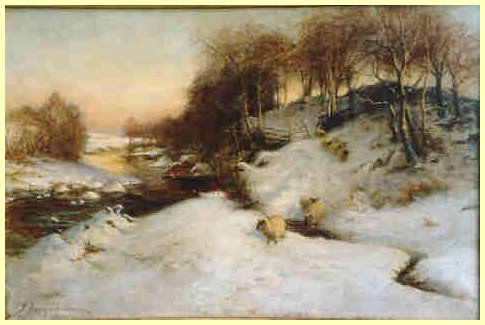
' Day's Dying Glow '
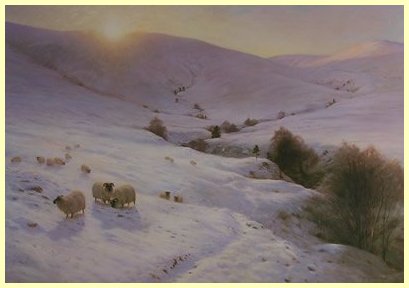
The Sun Peeps O're Yon Southern Hills
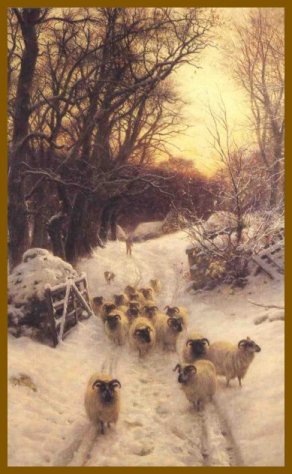
The Sun Had Closed the Winter's Day
© Towneley Hall Art Gallery and Museum, Burnley, Lancashire
Joseph inherited the title of Laird in 1918 after the death of his elder brother Robert, an MP. Joseph Farquharson trained at the Trustees’ Academy in Edinburgh during the 1860s. "The Painting Laird" studied first under Peter Graham R.A. and then at the Life School at the Royal Scottish Academy. The popular Scottish Landscape painter Peter Graham remained a close friend and his influence on Farquharson is unmistakable. Farquharson exhibited at the Royal Academy from 1873 and was elected an Associate in 1900. Farquharson is most famous for his works portraying sheep and his finest works often include a human figure. Men and women of Scotland going about their every day labors are frequently depicted in dramatic landscapes. Nearly all the early works were inspired by his rural surroundings and he went on to make snow scenes his trademark. Other subjects he often painted were burns and fly fishing.

Gathering Winter Fuel
Joseph Farquharson knew his subjects well. The remarkable success of his pictures rests with the fact they touch people from all walks of life. His canvases continue to be very popular today, in fact the originals are fetching record sums and their value climbs each year. Sadly, this has made them the target of art thieves of late. (See the bottom of this page for paintings still missing.) Farquharson's devotion to his beloved Scotland and attention to detail makes the compositions feel realistic even when the subjects are presented in a very Romantic fashion. Having been to Scotland I can tell you the beauty expressed in these pictures is not exaggerated. Being that I too am a shepherd who keeps Scottish Blackface sheep like those who graze so many of Farquharson's compositions, I can tell you he was a genius at capturing the movements and habits of these wild, almost feral sheep. It is the truth in his art that holds up with time. Artists like Rosa Bonheur and Sir Edwin Landseer often painted sheep in Scottish settings but they often made them resemble Rambouillets and other breeds from England and France. Although they were great artists, they did not know their ovine subjects as Joseph Farquharson knew his nor were they native Scots. Farquharson's love of his native soil jumps from his works. I should note here for the Faquharson admirer, there are many good reproductions being made of his paintings being issued as prints currently and they are very affordable. There is no reason anyone cannot enjoy one of his works on their wall.
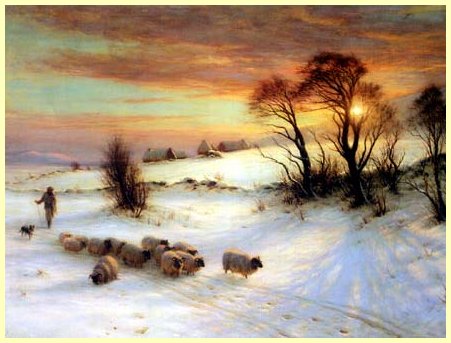
HERDING SHEEP IN A WINTER LANDSCAPE
Joseph Farquharson was most adept at capturing the warmth and light of sun rises and twilight. The watershed in his career was marked by three or four winters spent from 1880 onwards in Paris. There he studied under Carolus Duran, an admirer of Velazquez. Carolus-Duran taught his students to use the brush straight away and think in terms of form and color. As a result Farquharson’s work was always characterized by richly handled paint. Many of his paintings were completed in the North East of Scotland at his beloved Finzean. In 1885 he went to North Africa. Among the works created at this study time (1885-1893) were ‘The Egyptian’ and ‘On the Banks of the Nile outside Cairo’. These paintings are excellent but often go forgotten today.
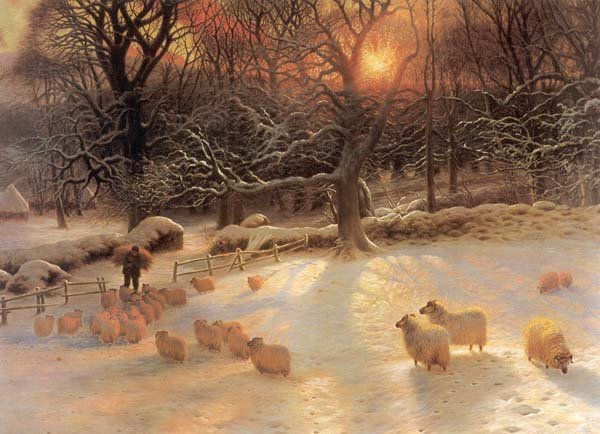
'The shortening winter's day is near a close'
1903
© Lady Lever Art Gallery, National Museums Liverpool
The unusual titles of many of Farquharson's paintings stand out and are sometimes long. Research shows that many of them were taken from poems by Burns, Milton, Shakespeare and Gray. Farquharson was very patriotic and well versed in Scottish literature. He was elected ARA 1890, RA 1915 and in addition to exhibiting over 200 works at the RA he showed 73 at the RSA and 181 at the Fine Art Society. Among many other exhibits at the RCA, GI, and the Tate AG. The renowned artist-critic, Sickert made Farquharson the subject of an essay comparing him with Courbet and preferring Farquharson. He extolled Farquharson's tension and realism and criticized the pretension of his polar opposites, the Bloomsbury Group, whose writ he said "fortunately does not run in the North of Scotland". The remarkable realism of Farquharson’s work can be attributed to his desire to work in "plein air". This had to be carried out in a unique way which was adapted to the harsh Scottish climate. Farquharson had constructed a painting hut on wheels, complete with a stove and large glass window for observing the landscape. Likewise to achieve as realistic a result as possible when painting the sheep which frequently appear in his snowscapes, he used a flock of "imitation" sheep which could be placed as required in the landscape of his choice. Farquharson painted so many scenes of cattle and sheep in snow he was even nicknamed ‘Frozen Mutton Farquharson’.
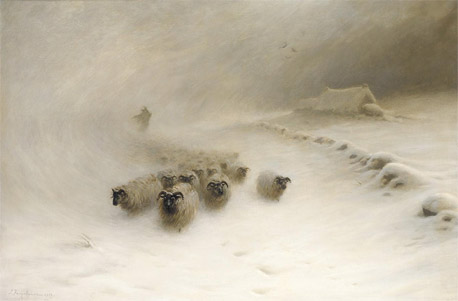
A FLOCK OF SHEEP IN A SNOW STORM
|

Sunlight and Shadow
Many More Paintings
Buy Farquharson Prints at:
References
Dictionary of Scottish Art & Architecture. Peter J M McEwan
copyright 2007 , Jim & Beth Boyle, All Rights Reserved
No part of this website may be used for any purpose ( including using images )
without written consent from The Rams Horn

